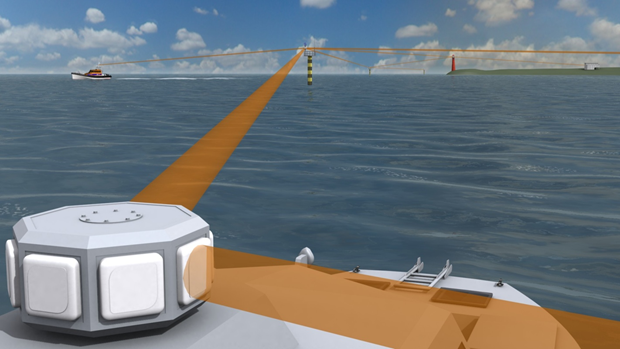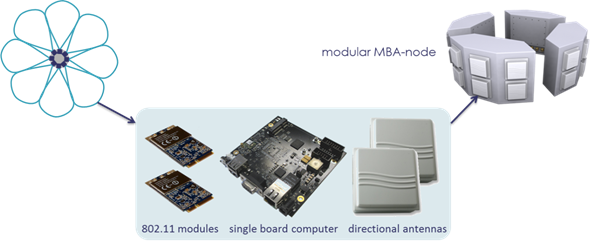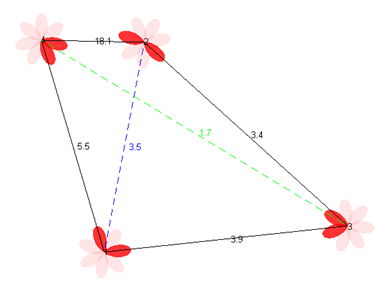Distributed Neighbourhood Discovery in MaritimeManet

Mobile Ad-hoc Networking at Sea
Maritime organizations increasingly conduct operations at sea using multiple, possibly unmanned, platforms. An example for the Coast Guard is ‘distributed surveillance’ in which a large operational area is collectively inspected by unmanned surface vehicles (USV) and unmanned aerial vehicle (UAV), each carrying sensors with limited coverage. Video, image and data communication among those platforms is indispensable for such operations, while the distance between platforms at sea is generally relatively large. The maritime environment thus poses challenges for suitable communication within multi-platform systems.
MaritimeManet is an ad-hoc self-organizing wireless network that addresses these challenges. For radio communication, a MaritimeManet node uses a number of beams arranged in a sunflower pattern as shown left in Figure 1. The middle of the figure illustrates how each beam is created with state-of-the-art WiFi radio modules, a single board computer and a panel antenna to enable long distances transmission. The beams collectively cover all directions and thus enable communication in all directions. The resulting node, shown right in Figure 1, is called a Multi-Beam Antenna (MBA).
The fundamental principle in MaritimeManet is to automatically discover other nodes and to set up the strongest possible wireless connection between two nodes within radio reach by selecting the ‘best’ antenna at both nodes. To support connectivity while nodes move with respect to each other, MaritimeManet periodically selects the ‘best’ antenna at all nodes, which may result in handover of a connection to an adjacent antenna of a node. Movement of nodes may also lead to automatic removal of connections or to automatic creation of new connections.

Figure 1 – Composition of a single beam using commercial-off-the-shelf components.
Problem Statement:
The algorithm that takes care of selecting the best possible connection in MaritimeManet is called Distributed Neighborhood Discovery (DND). To provide the information for DND to operate on, the control radio of each sector periodically transmits a ‘Sense’ message on a predefined, common frequency, and continuously listens for the ‘Sense’ messages of neighbouring nodes.
Figure 2 shows an example of the operation of DND. In this example there are four nodes, each having an MBA with seven beams (shown as flower leaves). A transparent leaf is not engaged, and a solid leaf is engaged in a wireless connection. The numbers along the lines between beams indicate the strength of the wireless connection, which largely depends on the distance between the nodes. The larger the distance, the weaker the received signal of the connection, and the less capacity the connection has. Based on received ‘Sense’ messages, DND determines a list of candidate connections, and makes the following decisions on them:

Figure 2 – Snapshot of a simulation of DND-operation.
- Valid connection (solid black line) – Is a radio connection between two peer sectors that results in the strongest connection between the respective nodes. DND will instruct to set up this connection using the data radios of the respective sectors and nodes, and a frequency that results in minimum interference with other connections.
- Weaker connection (green dashed line) – Is a radio connection emanating from the same sector a stronger connection exists. DND eliminates this candidate from the list.
- Slower connection (blue dashed line) – Is a valid connection between two nodes for which there is a two-hop path that is faster. DND eliminates this candidate from the list.
The result is a connected graph among the four nodes that optimizes the capacity and minimizes the number of wireless links needed for it. When in Figure 2 the ‘best’ antenna changes over time due to, e.g., rotation of node 1 (left under), the connection will be handed over to this new ‘best’ antenna, which will be the adjacent beams for the connections with node 3 (right-under) and 4 (left-upper). When the same node translates to the left, the node 4 will hand over its connection with node 1 to an adjacent beam, and when far enough moved, the connection with node 3 will disappear.
Tasks:
The concept of DND has been patented [1] and its operation has been described in detail in [2]. Practical validation of the protocol used in MaritimeManet has been performed during simple sea trials [3]. Although the basic idea of DND has thus been validated, there are many open issues c.q. aspects of the protocol that are not yet validated. During the early development of DND and MaritimeManet a list of useful additional capabilities and improvements for DND has been maintained [4]. The items in this list address both the functionality of the protocol as well as its implementation using standardized 802.11 functionality in COTS devices.
More specifically the student is expected:
- To identify possible weaknesses of DND, and propose solutions for the identified weaknesses;
- To make a computer model of the (improved) DND algorithm in order to show the functional correctness and scalability of DND;
- To make an implement of the improved DND alogoritm;
- To show the correctness of improved DND by demonstration
Work:
30% Theory, 50% Simulation, implementation and demonstration, 20% Writing
Contact:
Jan Laarhuis (j.h.laarhuis@utwente.nl)
Alessandro Chiumento (a.chiumento@utwente.nl)
References
[1] J.H. Laarhuis, ‘A maritime mobile ad-hoc network’, patent application EP 066836, 2012
[2] J.H. Laarhuis, ‘MaritimeManet Functional Architecture’, TNL internal report, 2018
[3] J.H. Laarhuis, ‘MaritimeManet – Breedband Netwerk op Zee’, eindrapport voor de Kustwacht, 2017 (in Dutch)
[4] J.H. Laarhuis, ‘DND-improvements’, spreadsheet with possible DND improvements, living document
